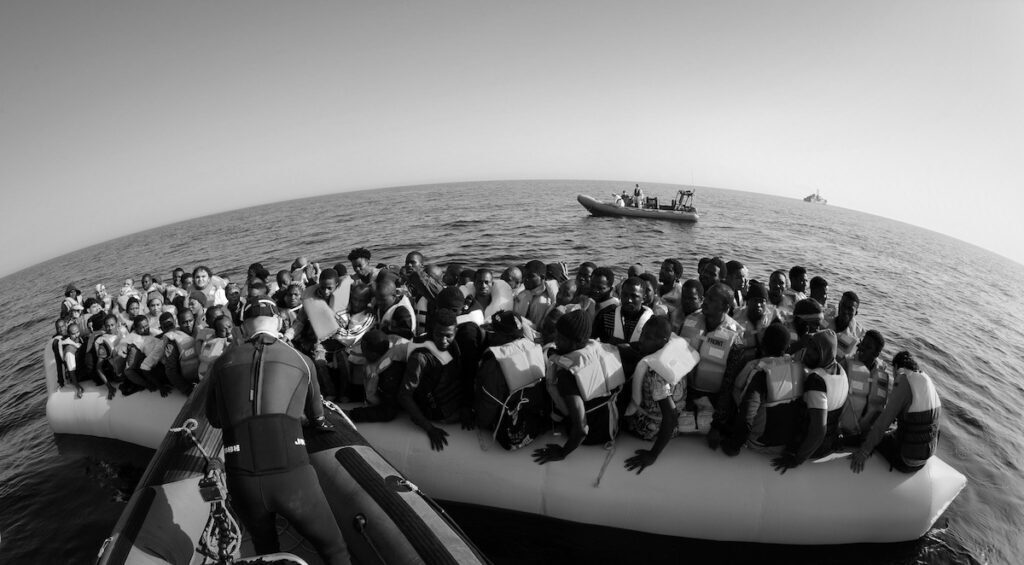Death and rescue in the Central Mediterranean: overcoming the limits of private outsourcing

The search-and-rescue operations in the Central Mediterranean were overall successful in saving thousands of lives in the years 2014-2017. Compared with the previous years, the rescues reduced and stabilised the fatality rate for the persons attempting a dangerous sea crossing. Several NGOs contributed significantly to this joint effort coordinated by the Italian Coast Guard’s Maritime Rescue and Coordination Centre (MRCC) and involving various Navies. However, more people died at sea in 2014-2017 than in the previous 14 years. This also means that the additional resources contributed by the private nonprofit organizations – a dozen vessels in the years 2015 and 2016 – did not have a significant impact on a further reduction of the fatality rate. This is probably due to a variety of factors, from the sheer size of the numbers involved to a substitution effect of private for public assets, and the intrinsic limits of private outsourcing of the direct provision of essential public services (especially when capacity and security considerations are paramount). Meanwhile, political figures and media outlets accused NGOs active in SAR operations of a sort of “moral hazard”, inducing migrants and smugglers to attempt riskier crossings on unseaworthy vessels in the hope of being rescued. While no evidence has emerged so far to back any of these charges, in the end public policies towards SAR operations shifted first in mid-2017 when the center-left Italian government asked the NGOs to abide by a “code of conduct”. One year later, the new center-right government closed the harbours to rescue vessels – even Italian ones, like the decision on the “Diciotti” CG vessel that proved extremely divisive and possibly illegal – and prevented the Coast Guard to further engage. This seems to hint at a transition towards the pre-2013 “normal” of few departures, few arrivals, no large scale SAR operations, no NGOs involvement, higher risk during the crossing, but overall fewer deaths.

In what follows I will focus on the overall deaths and missing persons in the Central Mediterranean and the fatality rates during the last fifteen years or so, in order to assess the relative impact of SAR operations. The fatality rate is calculated for each calendar year as the ratio of dead or missing persons over the total of those who attempted the crossing of the Central Mediterranean. The latter are estimated as the sum of those who arrived safely to Italy or other shores of the Central Mediterranean (and in recent years virtually all of these were rescued at sea), plus the dead and missing, plus those who have been returned to Libya by a SAR operation or interception of the Libyan Coast Guard (the great majority of attempted crossings originated from Libya, although there are reports of increased departures from Tunisia too). Using the annual aggregated data one clearly loses some granularity, but at the same time this brings the advantage of equalizing the strong seasonal effects of attempted crossing and tragic accidents at sea.
Read the full article on Security Praxis
The argument in a nutshell:
– two “normals”/equilibria: pre-2013 (fewer departures, fewer arrivals, fewer overall deaths, no rescues, high risks); 2013-2017 (more departures, more arrivals, more deaths, high SAR, lower risks); 2018: back to pre-2013?
– SAR operations stabilized the fatality rate at lower levels: 2% in 2014-2017 instead of 3-4% (with peaks of 5-8%) in 2000-2013;
– tens of thousand lives saved; but still, thousands died;
– even with 12 NGO vessels deployed in 2015-2016 the fatality rate did not decrease further (if anything, it slightly increased);
– long term dynamic driven by political changes in North Africa, power settlements, political shocks (Arab spring; fall of the Gaddafi regime; war in Syria; etc.);
– medium term (2013-2017) evolutionary dynamic (multiple agents/interests): more SAR capability -> changing incentives for smugglers -> higher risks for migrants (squeezed on rubber dinghies…) –> more SAR capability closer to Libyan coasts -> worse conditions for migrants … that draws in more SAR resources and keeps fatality rate still too high, and overall death levels higher than pre-2013;
– this dynamic regards SAR operations in general, not the much debated NGOs role (whose specific impact on the overall trend is limited); still there are the usual limits in the private outsourcing of a public service (SAR), especially if it has security implications (limited capacity of volunteer, nonprofit orgs, vulnerable to armed threats, no guarantees of continuity of service etc.);
– changes in policies by successive Italian governments (agreements with Libyan militias in 2017; closed harbours and halt to SAR in 2018) against a backdrop of EU’s stalemate on refugees/migrants “crisis”: back to an even harsher old “normal” of fewer departures, fewer arrivals, no rescues, high risks, fewer overall deaths;
– if the “high-intensity SAR” approach is unsustainable (morally problematic as implemented and politically unviable), better to focus on alternatives rather than decrying its demise. Which alternatives? For example, turning so-called “humanitarian corridors” with multi-stakeholder (states, UN agencies, NGOs) pre-screening of applicants from trickles to viable channels of entry for asylum seekers.
Acknowledgements
Cover photograph: LÉ Róisín Rescues 371* Migrants in Three Separate Search and Rescue Operations 37 Nautical Miles NW of Tripoli, taken on June 27, 2016, (CC) Óglaigh na hÉireann



